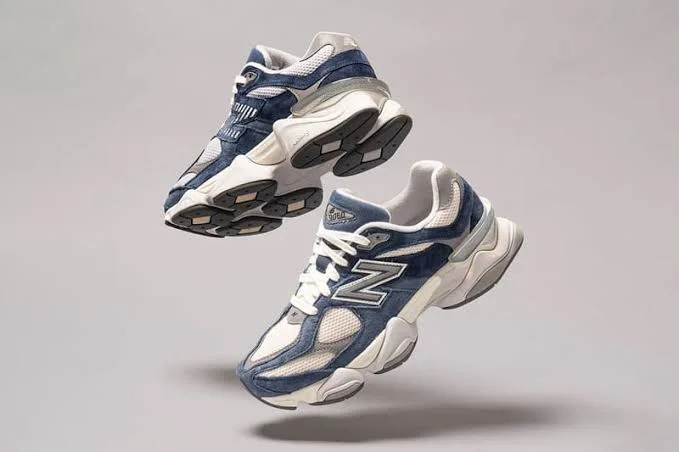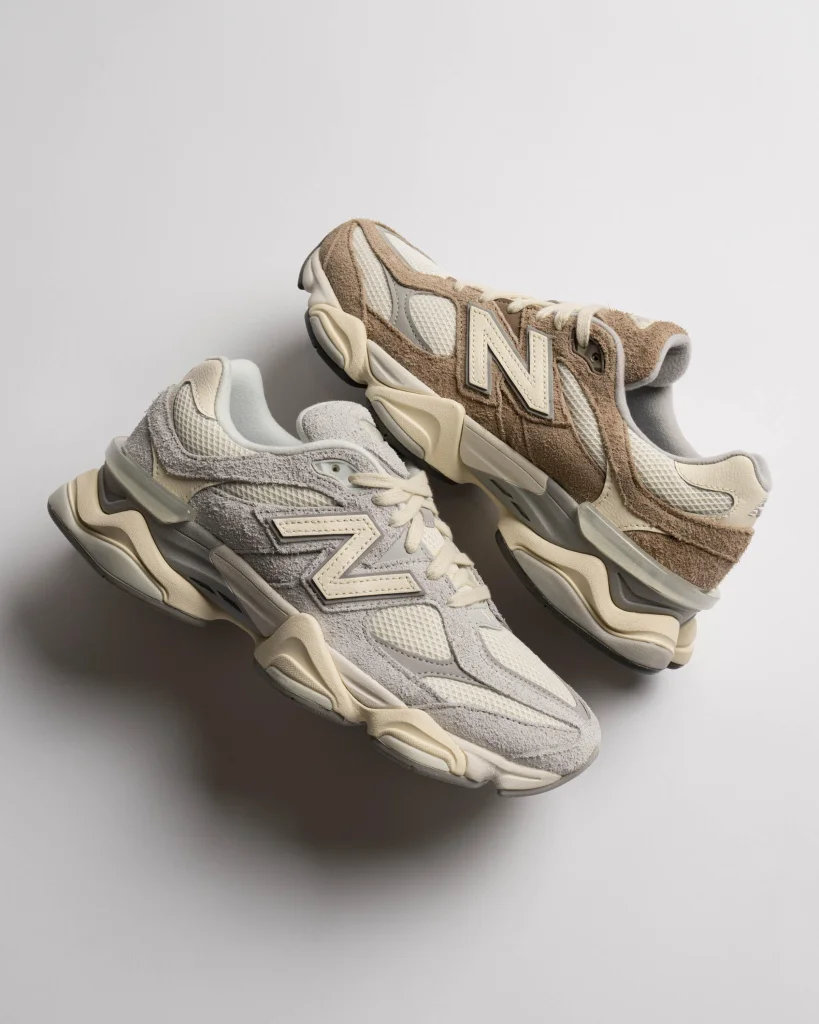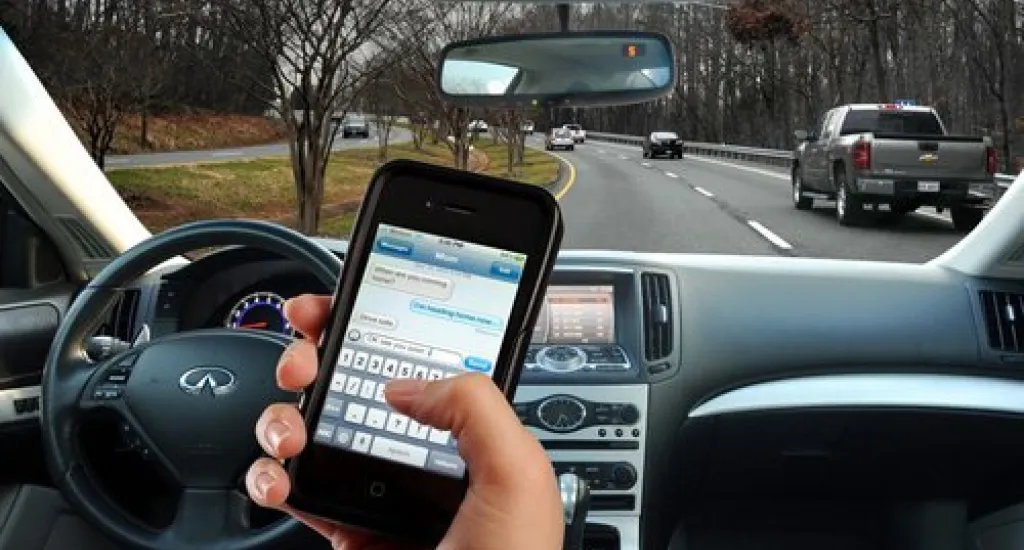
New Balance 9060:
The sneaker everyone from Naomi Campbell to your neighbor can't stop wearing
On a rainy Tuesday in November 2025, Sarah Chen stood in line outside a New Balance store in Manhattan, phone in hand, refreshing the stock page every thirty seconds. The Pearl Gray/Shoreline Blue colorway she'd been tracking for weeks had just dropped online, and she wasn't taking chances. Behind her, a college student scrolled through TikTok, showing his friend a video tagged #NB9060 that had already racked up 400,000 views overnight.
This scene—repeated in cities from London to Lagos, Seoul to São Paulo—tells the story of 2025's most unlikely sneaker phenomenon. In a year when slim, minimalist footwear was supposed to dominate, the chunky, retro-futuristic New Balance 9060 has managed to remain extraordinarily popular, defying fashion cycles and market predictions with a stubbornness that feels almost poetic.
The question isn't just why people keep buying the 9060. It's why, three years after its debut, this particular sneaker has become a cultural touchstone—a shoe that bridges generations, fashion tribes, and the persistent tension between comfort and style.
The Supermodel Effect
When Naomi Campbell emerged at Paris Couture Week in July 2025 wearing New Balance 9060s with a denim Adidas tracksuit, the fashion world took notice. Not because a supermodel wore sneakers to Fashion Week—that's been standard for years—but because of which sneakers she chose.
Campbell has since purchased three pairs in different colorways, treating them the way Sophie Turner hoards Adidas Sambas: as non-negotiable wardrobe staples. Before attending Dolce & Gabbana's Spring 2026 show in Milan, she wore them again—this time paired with an oversized denim jacket and baseball cap, leaning fully into their "dad-ish charm."
The fashion press catalogued every appearance. WWD noted the "scaled-up proportions" and gray mesh uppers. Marie Claire pointed out that Campbell's rare colorway would run upwards of $245, compared to the standard $160 retail price. But the real story wasn't price—it was validation.
"Campbell treats her New Balances the way Sophie Turner does her Adidas Sambas: She buys multiple colors in the same model." — Marie Claire, September 2025
When someone of Campbell's caliber—a woman who has spent decades defining what fashion means—chooses the same chunky sneaker for multiple international Fashion Week appearances, it sends a message. The 9060 isn't a trend piece or an ironic choice. It's legitimate.

And Campbell isn't alone. Since its 2022 launch, the Y2K-inspired 9060 has been frequently worn by Sydney Sweeney, Blackpink's Lisa, Margot Robbie, Hailey Bieber, and Jack Harlow, accelerating its transition from performance sneaker to fashion staple. These aren't paid endorsements or carefully staged brand partnerships. They're organic adoptions by people who could wear literally anything.
The Technology Behind the Trend
But celebrity endorsement alone doesn't explain why the 9060 has maintained momentum through 2025. The technical story matters too—and it's a story New Balance has been refining since the brand's founding in 1906.
The 9060 reinterprets familiar 99X elements with a warped sensibility inspired by the proudly futuristic, visible tech aesthetic of the Y2K era. Sway bars taken from the iconic 990 are expanded and utilized throughout the entire upper for a sense of visible motion. Wavy lines and scaled-up proportions on a sculpted pod midsole place exaggerated emphasis on the familiar cushioning platforms of ABZORB and SBS.
Translation: It looks aggressive and futuristic, but it feels like walking on clouds.
The dual-density midsole featuring ABZORB and SBS cushioning isn't just marketing speak. ABZORB cushioning was designed to absorb shock and offer a responsive feel, while the SBS (Stability Web System) provides structural support. The result is a shoe that delivers both comfort and performance—critical factors in an era when people expect their sneakers to work for 12-hour days, not just Instagram photos.
"Comparisons are often made with other popular models known for their cushioning, such as the Ultra Boost and Yeezy Boost," noted a July 2025 review. "The 9060 has emerged as a strong competitor in terms of comfort, making it a favorite for those who value enduring wearability."
This matters more than you might think. In a world where athletes are constantly fighting to reclaim their physical promise, and where professionals spend increasing hours on their feet, comfort isn't a luxury—it's non-negotiable. The 9060 delivers it without compromising aesthetics.
The Social Media Amplification

If celebrity endorsement provided credibility and technology provided substance, social media provided rocket fuel. The #NB9060 hashtag garnered 12 million TikTok views in Q1 2025 alone, with influencers ranging from celebrity trainers to fashion students showcasing styling possibilities.
The content isn't professionally produced advertising—it's genuine enthusiasm. A mom in Texas shows how she styles her 9060s with jeans for school pickup. A college student in Seoul demonstrates pairing them with oversized streetwear. A fitness influencer in London wears them for "everything from gym sessions to coffee runs."
This organic virality created something traditional marketing can't manufacture: cultural saturation. When millions of people see the same shoe styled dozens of different ways across weeks and months, it stops being a product and becomes a reference point. "Oh, those are like the New Balance 9060s" becomes shorthand for a specific aesthetic—chunky but not clunky, retro but not dated, comfortable but not frumpy.
The TikTok effect also solved a problem that often plagues sneaker releases: limited imagination. When consumers can only see official product photos, they struggle to envision how shoes fit into their actual lives. But when thousands of real people share outfit combinations, styling hacks, and honest reviews, the psychological barrier to purchase collapses.
Much like how Marvel Rivals built momentum through strategic hype, the 9060 benefited from sustained, authentic engagement rather than manufactured buzz.
The Colorway Strategy
New Balance quietly launched two new colorways in early November 2025—Pearl Gray/Shoreline Blue and Gray Matter/Pink Taffy—without much fanfare. Both pairs are connected through their use of gray, matching color blocking, and distinctive neon green accents on their branding and midsoles.
This low-key approach mirrors the brand's broader strategy. Unlike competitors who build massive hype campaigns around limited drops, New Balance has treated the 9060 as a continuous presence rather than a scarcity event. Data shows kids' colorways consistently dominating search interest, peaking at 94 in August 2025, while women's colorways experienced the highest spike (85) in December 2024, aligning with holiday shopping patterns.
The colorway diversity matters because it allows consumers to express individual style while wearing the same fundamental shoe. Someone drawn to muted, neutral tones can find their version of the 9060. Someone who wants a statement piece can too. This breadth of choice—executed thoughtfully rather than overwhelming—has helped the 9060 avoid the fate of many trendy sneakers: rapid market saturation followed by swift cultural rejection.
New Balance has released dozens of colorways since 2022, including collaborations with designers like Joe Freshgoods (the "Inside Voices" collection that launched the model), Teddy Santis, and Japanese retailer Beams. Each partnership brought fresh perspectives without diluting the core identity. The 9060 remained recognizable even as it evolved.
The Demographics of Desire

Perhaps most fascinating is how the 9060 transcends typical demographic boundaries. The sneaker is "beloved by both young and older demographics", a rare achievement in fashion's heavily age-segmented market.
Gen Z consumers appreciate the Y2K nostalgia and the streetwear credibility. Millennials recognize echoes of the chunky sneakers they wore (or wished they could wear) in the late 1990s and early 2000s. Gen X and older buyers value the comfort and build quality—the sense that this is a real shoe designed by people who understand biomechanics, not just aesthetics.
This cross-generational appeal reflects something deeper: exhaustion with planned obsolescence and trend churn. People are tired of buying shoes that look great but fall apart in six months, or that require sacrificing comfort for style. The 9060 offers an alternative—a shoe built to last, designed to work, priced reasonably enough ($150-$160 standard retail) that it's accessible to middle-class consumers.
In that sense, the 9060's success mirrors broader cultural shifts. Just as families are fighting against manufactured scarcity in essential goods, sneaker consumers are pushing back against the artificial scarcity and inflated pricing that has defined sneaker culture for years.
The Performance Paradox
Interestingly, the 9060's success as a lifestyle sneaker comes despite—or perhaps because of—its performance DNA. The shoe features a mixture of breathable mesh and high-quality suede overlays, ensuring both durability and breathability. The construction materials—synthetic leather, mesh, neoprene—were chosen for function first, fashion second.
Yet this performance heritage enhances rather than limits its fashion appeal. In November 2025, when authenticity is currency and consumers are increasingly skeptical of "fashion" products that sacrifice utility, having legitimate technical credentials matters. The 9060 isn't pretending to be a running shoe—it genuinely incorporates running shoe technology. You could run in them if you wanted. Most people don't, but knowing you could creates psychological permission to wear them confidently.
This is the same principle that makes certain outdoor brands fashionable in cities: Arc'teryx works in the mountains, which is why it works in Manhattan. The 9060's technical legitimacy provides fashion validity.
The Retail Reality
Of course, popularity creates its own problems. Limited stock for certain colorways and sizes has complicated purchase decisions throughout 2025, with some sought-after versions selling out within hours of release. This scarcity wasn't entirely intentional—New Balance has struggled to meet demand while maintaining production quality.
The company has responded by expanding production and distribution, but carefully. They've resisted the temptation to flood the market, understanding that some healthy tension between supply and demand maintains desirability. It's a delicate balance: produce too few and you frustrate potential customers; produce too many and you risk market saturation.
New Balance now offers the 9060 in an unprecedented range of sizes, from men's 4 through 17, acknowledging that exclusion based on size is both bad business and bad ethics. This expansion has helped maintain momentum by ensuring more people can actually buy the shoes they want.
The Competition Question
The 9060's success hasn't occurred in a vacuum. New Balance's broader portfolio—particularly models like the 574, 990, and 327—continues performing well. The 327 model saw its highest search volume (100) in November 2024, likely driven by holiday shopping and its lighter, more minimalist design.
Yet the 9060 occupies a distinct niche. While the 327 appeals to consumers wanting something sleek and versatile, the 9060 attracts those seeking statement footwear with substance. They're not competing products so much as complementary options for different contexts and moods.
Against external competitors—Nike's chunky offerings, Adidas's retro lines, Hoka's maximalist runners—the 9060 holds its own through superior comfort-to-style ratio and more accessible pricing. Where Nike and Adidas have leaned heavily into limited collaborations and artificial scarcity, New Balance has emphasized availability and consistency. Different strategies for different markets.
The Cultural Moment
Understanding the 9060's success requires understanding November 2025's broader cultural context. We're living through what sociologists call "convergence fatigue"—exhaustion with the pressure to constantly adopt new trends, abandon old preferences, and maintain perfectly curated aesthetic identities.

The 9060 offers relief from that pressure. It's recognizable enough that wearing it signals you're paying attention, but versatile enough that you can style it your own way. It's not a statement of tribal affiliation (like, say, wearing Yeezys or Jordan 1s) so much as a statement of practical aesthetics: I want shoes that look good and feel good, and I refuse to choose between those priorities.
This philosophy resonates across demographics and geographies. Whether you're a supermodel attending Fashion Week or a parent doing school pickup, whether you live in New York or New Delhi, the fundamental appeal is the same: quality, comfort, style, and authenticity without pretension.
In that sense, the 9060's story mirrors other 2025 success stories—products and platforms that succeed by rejecting artificial scarcity and manufactured hype in favor of consistent quality and genuine utility. Much like how Spike Eskin reshaped WFAN by prioritizing substance over spectacle, New Balance has built the 9060's success on fundamentals rather than gimmicks.
The Styling Equation
Part of the 9060's enduring appeal is its styling flexibility. Social media has demonstrated this in real time throughout 2025, with users pairing the sneakers with everything from tailored suits to athletic wear, vintage denim to contemporary streetwear.
The key is the shoe's visual balance. It's chunky enough to ground oversized fits without disappearing, but not so bulky that it overwhelms slim silhouettes. The Y2K aesthetic references are clear enough to read as intentional, but not so literal that the shoe feels costume-like. The colorways range from neutral to bold, allowing wearers to choose their level of statement-making.
This versatility matters because contemporary style increasingly resists rigid categorization. People don't want different shoes for work, weekend, and workouts—they want shoes that can move between contexts with minimal friction. The 9060 delivers that flexibility without compromising on any single dimension.
The Sustainability Subtext
Though New Balance doesn't heavily market this angle, the 9060's durability represents a form of sustainable consumption. Consumer sentiment increasingly favors eco-friendly materials, but perhaps more important is longevity. A shoe that lasts three years and remains stylistically relevant reduces consumption far more effectively than a biodegradable shoe that needs replacement every season.
The 9060's construction—quality materials, thoughtful engineering, classic-but-contemporary design—positions it for extended wear cycles. This isn't fast fashion footwear designed to self-destruct after a few months. It's a shoe built to be used, maintained, and kept.
This approach aligns with growing consumer rejection of disposable culture. People are tired of buying things that break, and they're tired of being told their year-old purchase is "out of style." The 9060 pushes back against both problems simultaneously.
The Future Trajectory
So where does the 9060 go from here? Market analysts predict continued strong demand for chunky sneakers in the short term, with the 9060's design versatility positioning it as a staple in New Balance's lineup long-term. The brand's $10 billion sales target hinges partially on expanding into emerging markets, where the 9060's $150 price point offers a compelling value proposition.
New Balance could potentially expand the line into performance-oriented variants, though this risks diluting the model's identity. More likely, they'll continue the current strategy: consistent quality, regular colorway releases, selective collaborations, and gradual expansion of availability without market flooding.
The real test will come in 2026 and beyond, as fashion cycles continue evolving. Will the 9060 prove to have genuine staying power, or is it riding a temporary wave of Y2K nostalgia and chunky sneaker preference? Early indicators suggest the former—three years into its lifecycle, the shoe shows no signs of cultural exhaustion.
The Human Stories
Beyond market data and trend analysis, the 9060's success is built on individual stories. The college student who saved up for their first pair and wore them to every important occasion freshman year. The nurse who found sneakers that could handle 12-hour shifts without destroying their feet. The parent who appreciated having one shoe that worked for both playing with kids and looking presentable at school events.
These aren't the narratives that make headlines, but they're the ones that sustain products beyond hype cycles. When a shoe becomes woven into people's actual lives—when it's the shoe they wore during job interviews, first dates, family gatherings, ordinary Tuesdays—it transcends fashion and becomes something more personal.
This is perhaps the most significant achievement of the New Balance 9060 in November 2025: it has managed to matter to people in ways that extend beyond its function as footwear. It represents values many consumers are seeking—quality without pretension, style without sacrifice, presence without dominance.
"The 9060 is inspired by New Balance's fan-favorite 99X line, updated with 'warped sensibility inspired by the proudly futuristic, visible tech aesthetic of the Y2K era.'" — New Balance Product Description
The Takeaway
Standing in that New Balance store in Manhattan, Sarah Chen finally secured her Pearl Gray/Shoreline Blue pair. As she left the store, she passed a teenager wearing the Sea Salt colorway, a businessman in the Triple Black, and a woman in her sixties sporting the Moonrock version.
Four different people, four different styles, one shoe. That's the story of the New Balance 9060 in November 2025—not a trend, but a phenomenon. Not a fashion statement, but a practical choice that happens to look good. Not a solution to every footwear need, but a compelling answer to the question: "What do I wear when I want to look good, feel comfortable, and not think too hard about it?"
In an era of overwhelming choice and manufactured scarcity, of influencer marketing and algorithmic manipulation, the 9060 succeeds by being straightforward: a well-made shoe that looks distinctive, feels great, and costs what it's worth. Sometimes the most disruptive product is simply a good one.
As we move deeper into winter 2025, with new colorways launching and social media engagement remaining strong, the 9060 shows no signs of fading. Like trusted analysts who earn credibility through consistency rather than hot takes, the 9060 has built its reputation through performance rather than promises.
The question isn't whether the New Balance 9060 will remain relevant. The question is how many more pairs people will buy before they're satisfied—and judging by Naomi Campbell's collection, the answer might be: there's always room for one more colorway.
Related Articles




